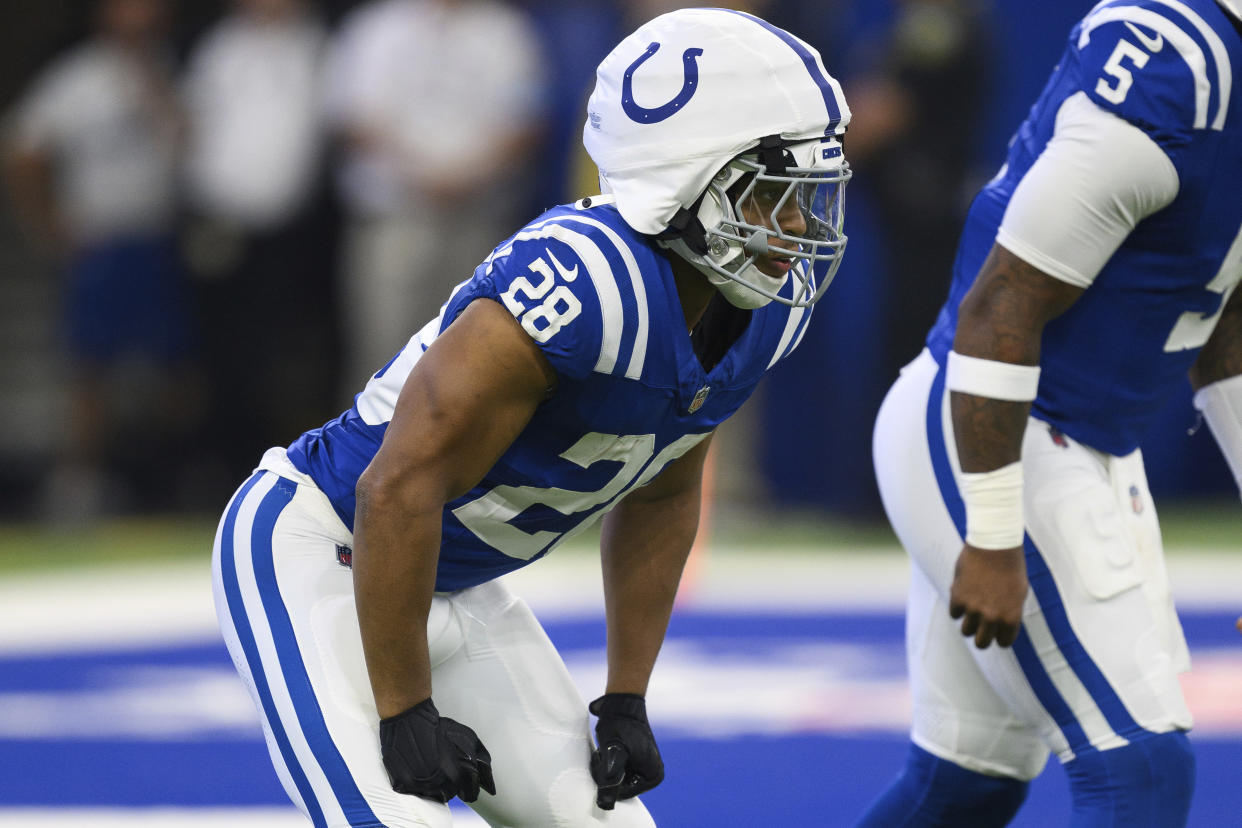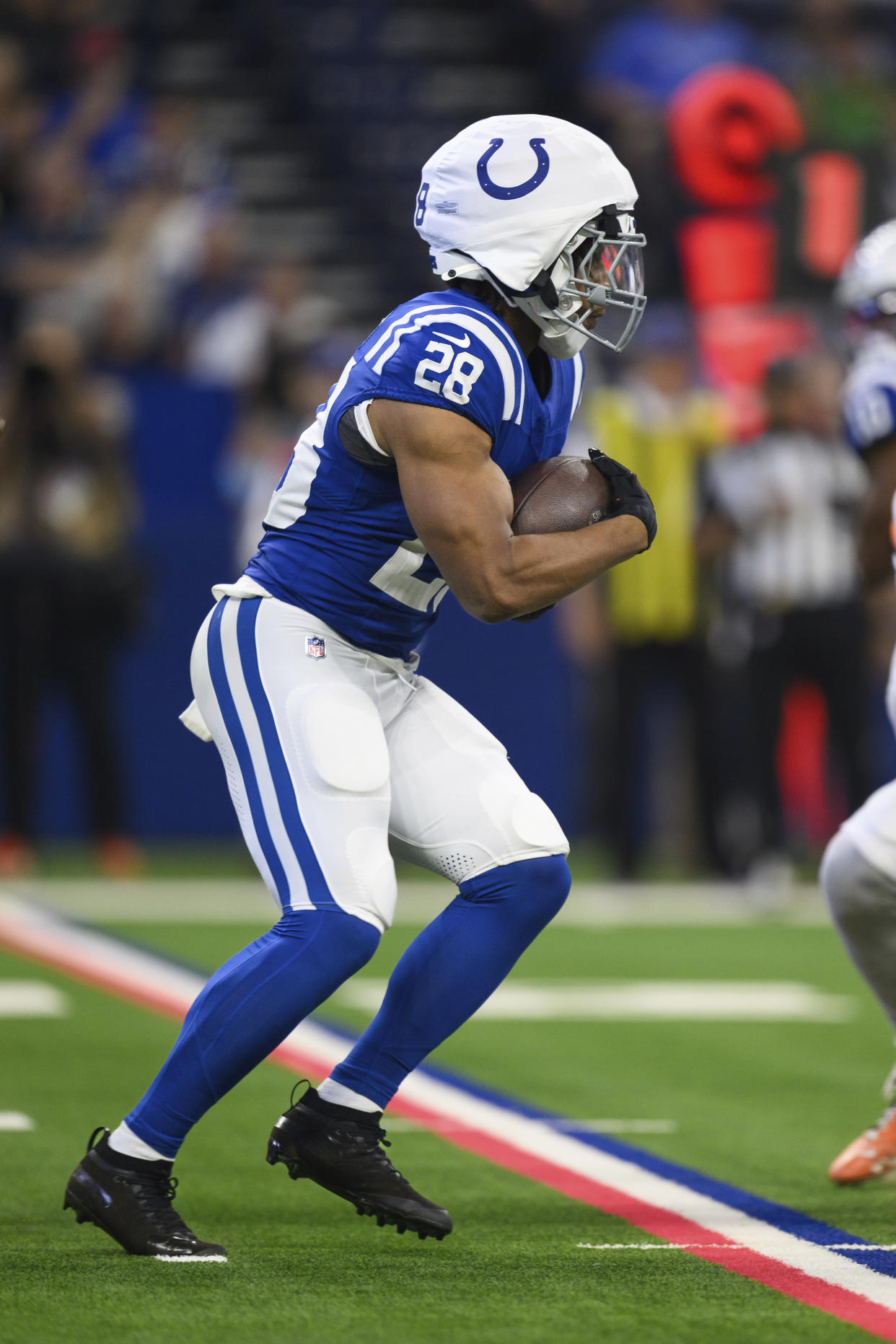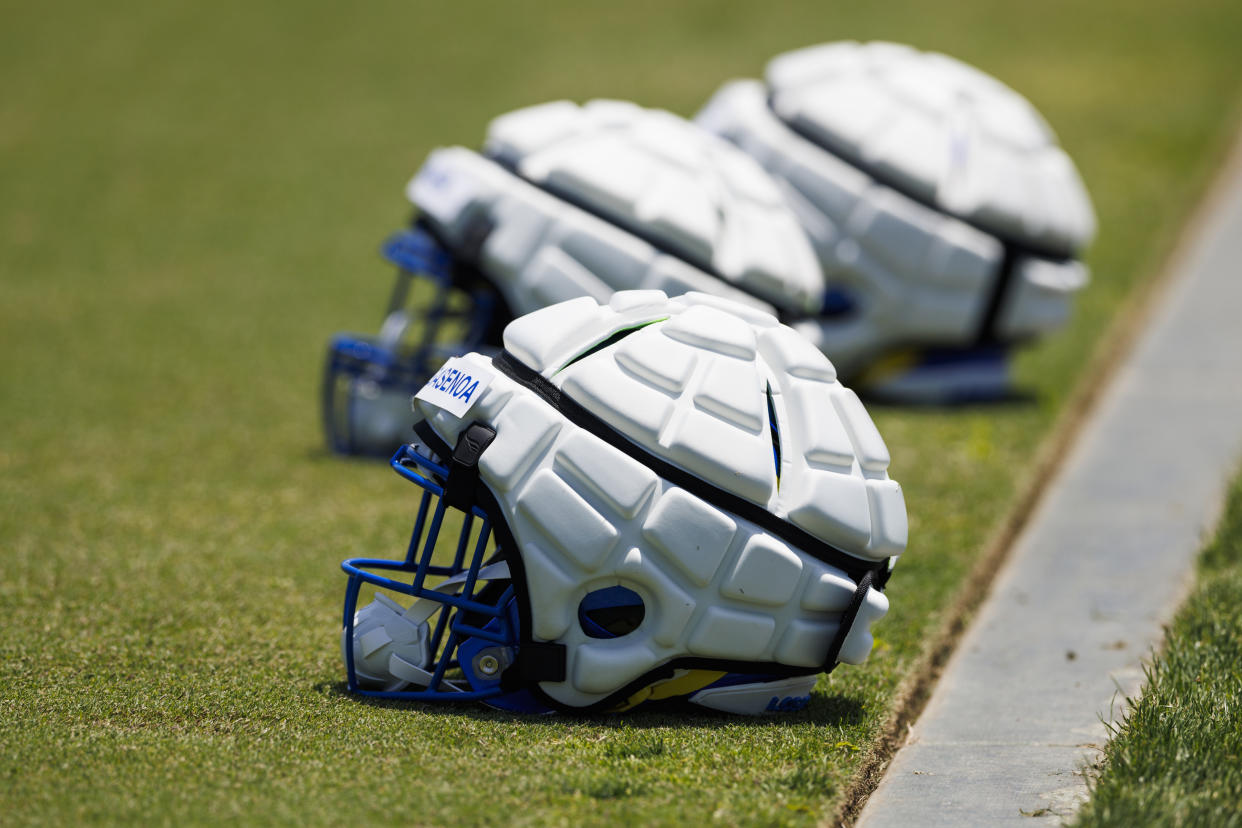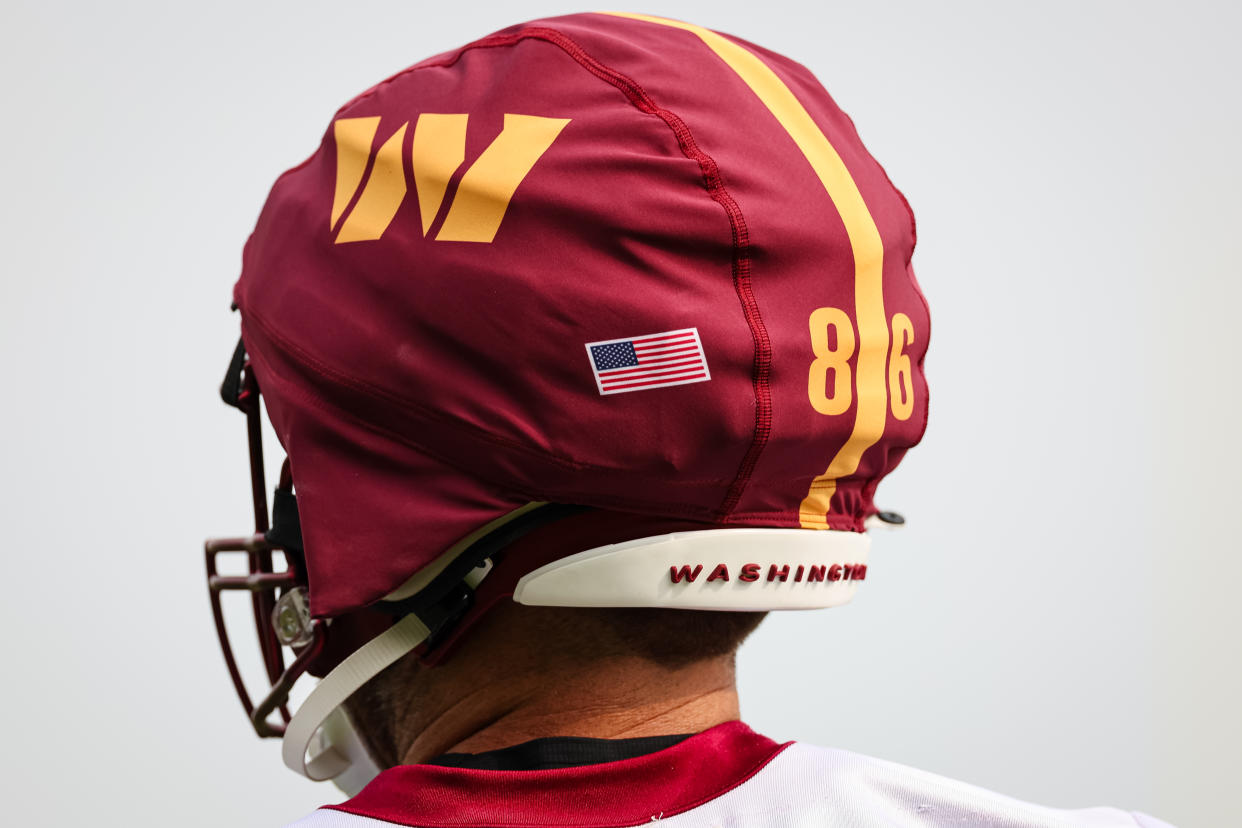Will Guardian Caps solve football's concussion problem? The NFL is trying.

When the Indianapolis Colts’s Jonathan Taylor took to the field for Sunday’s preseason matchup against the Denver Broncos, the running back became, arguably, the highest profile NFL player to wear a Guardian Cap during a game.
The 2024-2025 season, which officially kicks off Sept. 5, marks the first time the NFL is allowing players to wear these special covers during games. Taylor, 25, is already mandated to have a Guardian Cap on during practice, so he’s decided to test wearing it throughout preseason and see if it affects his game.
“Does it inhibit me from being able to complete my job at a high level? I’m going to keep wearing it throughout the preseason and make that evaluation, but it’s hard to tell without live game action,” he told FanDuel TV.
“The first game I had, it did not feel different,” Taylor added. “It felt like practice. Of course, it was only limited snaps … but so far, it didn’t feel different.”
Teammate Zavier Scott was another of the five Colts to sport a Guardian Cap. “Our (medical and equipment) guys here do a great job of keeping us informed,” he told IndyStar. “They’ve done the testing, and I don’t know the numbers, but they say it (offers) a significant reduction in concussions.”
The cap can absorb at least 10% of the force of a hit, according to NFL research. But what exactly are they? And can they solve football's concussion problem?
What is a Guardian Cap?
A Guardian Cap is a soft-shell helmet cover that fits over a football helmet. These caps are “engineered for impact reduction,” Erin Hanson, founder and CEO of Guardian Innovations, which makes Guardian caps, tells Yahoo Life. “It brings a padded, soft-shell layer to the outside of the decades-old hard-shell helmet and reduces impact up to 33%,” Hanson adds.
These caps are one-size-fits-all and move separately from the helmet. That allows for shifting at impact, which redirects energy, Hanson explains.

Why was it created and what does it do?
The Guardian Cap was created by Erin and Lee Hanson in 2010 in an attempt to tweak the design of the football helmet and protect players from head injuries.
“The Guardian Cap addresses the impact severity of blows for athletes,” Hanson says. “It reduces radiant heat up to 20 degrees and protects helmet wear and tear.” With the cap in place, the helmet’s hard shell receives less force and then transfers less force to the interior helmet padding, which touches the player’s head, Hanson explains.
Is it enough to offset concerns about CTE and concussions?
A huge issue for the NFL and football in general over the past few years is concerns about head injuries, specifically chronic traumatic encephalopathy (CTE) and concussions. CTE is a neurodegenerative disease linked to repeated trauma to the head that causes symptoms that are similar to those of Alzheimer’s disease, according to the National Institutes of Health (NIH). In a recent study of 152 brains that were donated to a brain bank, researchers discovered that ¾ of those with CTE played football. Those players with CTE typically had longer playing careers than people without CTE. Other people diagnosed with CTE played ice hockey, soccer, wrestling or rugby.
Concussions, which are mild traumatic brain injuries that can impact brain function, are somewhat common in football, with the NFL reporting 219 concussions and 422 evaluations for concussions during the 2023-2024 season.
Over the past few years, there has been increasing pressure on the league to reduce head injuries.
So, can these caps help? There isn’t a lot of data right now to suggest that the caps will protect against head injuries. One study that analyzed data from 42 NCAA Division I football players found that there was no difference in several measurements of head impacts when players wore the caps. “This study suggests Guardian Caps are not effective in reducing the magnitude of head impacts experienced by NCAA Division I American football players,” the researchers concluded.

Guardian Cap says on its website that studies conducted at Stanford University show an average reduction of 10% to 25% of head acceleration response metric (or HARM). But a 2023 study conducted by Stanford University researchers found “no significant differences in any measure of head impact magnitude were observed between the bare helmet impacts and padded helmet impacts.” While the researchers found that the shields did, in fact, reduce HARM by up to 25% they also said that the caps “did not significantly attenuate linear head accelerations for all helmets.”
“I don't think it'll make a big difference for the kind of blows that don't lead to concussion, but happen frequently on the field,” study co-author David Camarillo, an associate professor of bioengineering, said in a statement. (Worth noting: That study was small and limited to just 10 players.)
Camarillo tells Yahoo Life that it’s difficult to know whether Guardian Caps will lower the risk of concussions because the NFL hasn’t published its data on this or shared it in a peer-reviewed format, which is standard for researchers. “CTE may be caused by concussions in addition to ‘sub-concussive’ blows,” he says. “Since most of these sub-concussive blows are in the face/forehead region where Guardian Cap does not cover the helmet, it is unlikely to reduce CTE risk.”
That doesn’t mean the Guardian Cap can’t help, per Camarillo — it’s just unclear at the moment. “The only way I can imagine it would reduce CTE risk is if it significantly reduced concussions through its protection on other parts of the head,” he says. “The NFL needs to publish its data in a peer-reviewed scientific format to know more.”
Still, some doctors arel hopeful that Guardian Caps will do something. “The expectation and the hope is that they reduce the brain’s exposure to concussive events,” Dr. Ilan Danan, a sports neurologist at the Center for Sports Neurology and Pain Medicine at Cedars-Sinai Kerlan-Jobe Institute in Los Angeles, and neurology consultant for the Los Angeles Angels, Los Angeles Kings and Anaheim Ducks, tells Yahoo Life.
Danan says that there’s no data right now on whether these caps will help to lower the risk of developing CTE. “Primarily, the focus right now is on reducing acute injury,” he says. “If the Guardian Cap is doing what we’re hoping, it will reduce those concussive events. The belief is that, if we’re reducing those, it would translate to a lower risk of developing CTE later in life.”

Reported concussion rates have dropped slightly in the NFL over the past few years, but held relatively steady from the 2022-2023 to 2023-2024 season. The NFL reported a 52% drop in concussions the first year the league mandated that certain position groups wear the cap during the preseason, along with other changes in an attempt to lower the risk of concussions. However, the NFL said this in a report: “The concussion rate for players who wore the Guardian Cap for the mandated period did not increase after the mandate ended, and there was no significant change in concussion rates for the positions that did not wear the Guardian Caps.”
Who is wearing a Guardian Cap?
It’s common for NFL players to wear Guardian Caps during training, but this is the first year that the league is allowing players to use them during games. Taylor is one player who has worn the cap in games, along with his teammate, tight end Kylen Granson.
Pittsburgh Steelers offensive lineman James Daniels has worn the cap during a game, too. “My head doesn’t hurt, so that’s good,” he said after the game, Brian Batko of the Pittsburgh Post-Gazette reported. "Hopefully more and more people start wearing them.”
Are there certain football positions that might benefit most?
Positions that suffer from repetitive hits are the most likely to benefit from the caps, Danan says. The NFL currently mandates that these groups wear the caps in practice sessions:
Offensive lineman
Defensive lineman
Linebackers
Tight ends
Running backs
Full backs
Wide receivers
“The only players not required to wear the Caps are kickers, punters and quarterbacks,” Hanson says.
Why aren't more players wearing it?
Guardian Caps are still relatively new and, as online chatter shows, not everyone loves the look of them. Hanson also says that history of the sport may play a role.
“Football players, coaches and fans are all creatures of habit. Any change in any aspect of the game, like the addition of the Guardian Cap, is going to result in some criticism,” she says. “It happened when the helmets changed from leather to the hard-shell plastic. There has been some backlash regarding the aesthetic aspect of the cap, but we continue to innovate the caps for game day use.”
Danan expects more players to start wearing the caps in the future. “It’s all evolving,” he says. “All of the NFL teams are wearing them in practice. They’ve gained a lot of popularity.”


